CQU HRMT20024 Term 2 Essay: Attracting and Retaining Staff
VerifiedAdded on 2023/06/04
|16
|3741
|337
Essay
AI Summary
This essay delves into the critical human resource management (HRM) challenges facing the healthcare industry. It explores issues such as employee retention, job satisfaction, and the impact of inadequate talent management, including limited career advancement and insufficient training. The essay examines the work-life balance challenges nurses face, the difficulties in recruitment, and the importance of teamwork in providing effective patient care. It also discusses the consequences of HRM issues on patient health outcomes. The essay highlights the significance of addressing these challenges to improve service quality and patient well-being within the healthcare sector, emphasizing the need for effective strategies in staff retention, recruitment, and overall HRM practices.
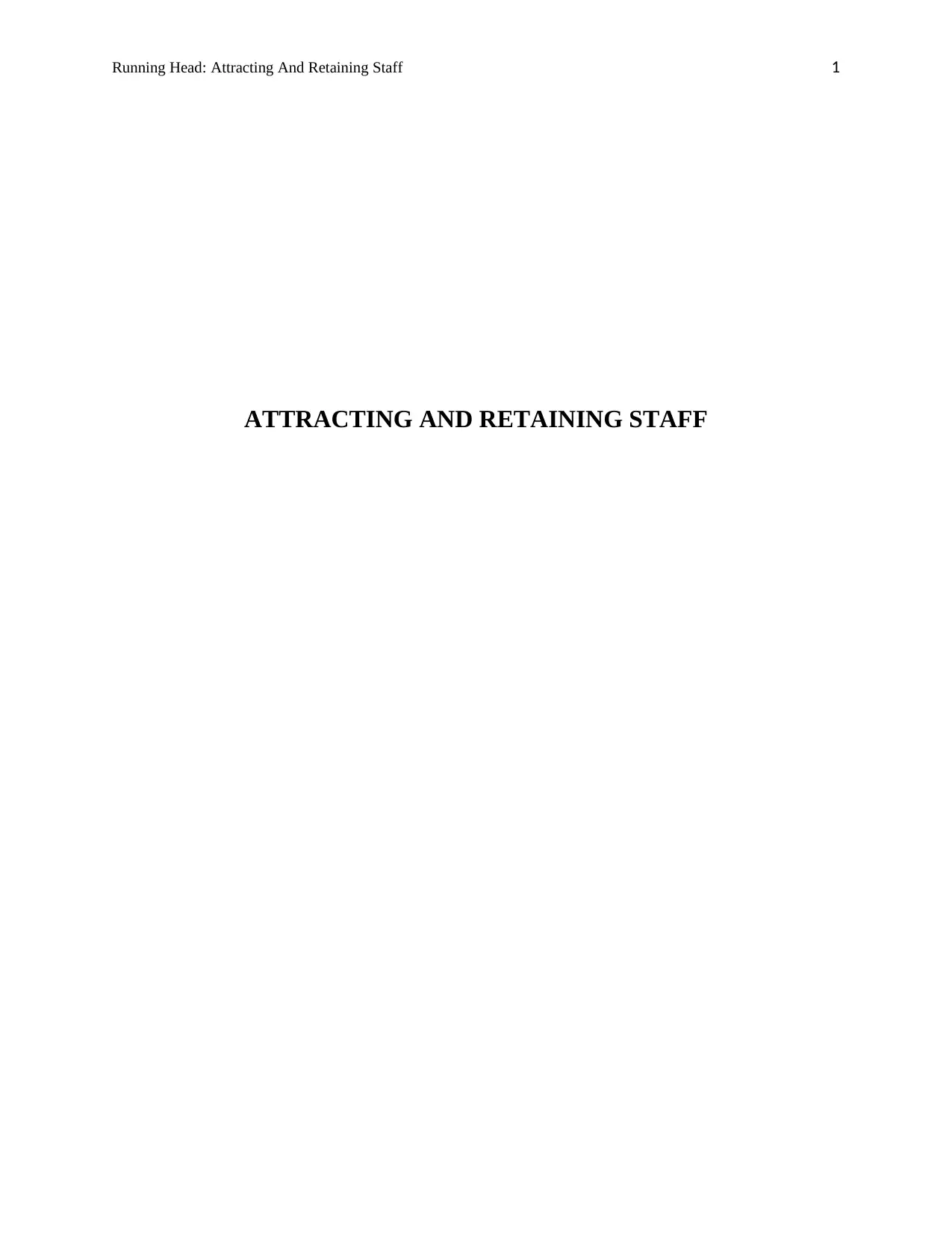
Running Head: Attracting And Retaining Staff 1
ATTRACTING AND RETAINING STAFF
ATTRACTING AND RETAINING STAFF
Paraphrase This Document
Need a fresh take? Get an instant paraphrase of this document with our AI Paraphraser
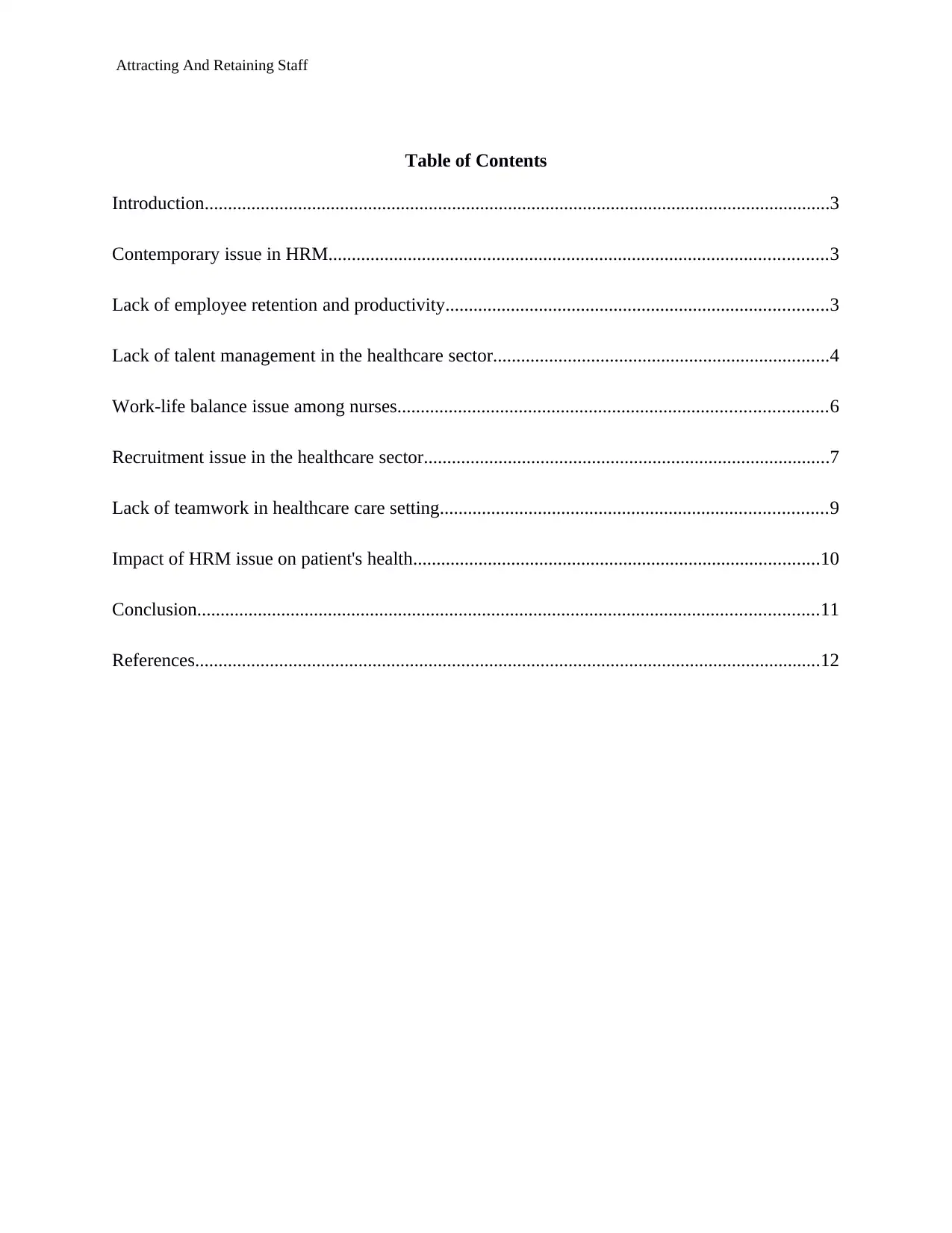
Attracting And Retaining Staff
Table of Contents
Introduction......................................................................................................................................3
Contemporary issue in HRM...........................................................................................................3
Lack of employee retention and productivity..................................................................................3
Lack of talent management in the healthcare sector........................................................................4
Work-life balance issue among nurses............................................................................................6
Recruitment issue in the healthcare sector.......................................................................................7
Lack of teamwork in healthcare care setting...................................................................................9
Impact of HRM issue on patient's health.......................................................................................10
Conclusion.....................................................................................................................................11
References......................................................................................................................................12
Table of Contents
Introduction......................................................................................................................................3
Contemporary issue in HRM...........................................................................................................3
Lack of employee retention and productivity..................................................................................3
Lack of talent management in the healthcare sector........................................................................4
Work-life balance issue among nurses............................................................................................6
Recruitment issue in the healthcare sector.......................................................................................7
Lack of teamwork in healthcare care setting...................................................................................9
Impact of HRM issue on patient's health.......................................................................................10
Conclusion.....................................................................................................................................11
References......................................................................................................................................12

Attracting And Retaining Staff
Introduction
Human resource management controls many issues like employee relation, staff retention
and recruitment, legal matters. In this essay, the healthcare industry is chosen. The human
resource practices improve the overall patient health delivery and outcomes of healthcare
services. The HR department gains profit by overcoming all the challenges such as health care
regulation, economic instabilities. In this essay various healthcare related issues such as
employee retention issues due to job dissatisfaction, stress and other contemporary issues in
HRM are going to discuss. Proper management in human resource provides a high-quality
service to the patient whereas poor management causes life and death factor for the patient.
Contemporary issue in HRM
Lack of employee retention and productivity
The human resource is significantly important in any healthcare industry to run smoothly.
The human resource department depends on the ability of the employees like nurses and other
staffs to provide the patient with the best services in an efficient manner. According to Asegid,
Belachew & Yimam (2014) in the healthcare industry, the anticipated turnover and job
satisfaction among the nurses are great factors.
Employee retention
The qualified nurses are not retained and separated from the health industry and as a
result, there is a significant vacancy in the operation which effects in providing the service to the
customer.
Introduction
Human resource management controls many issues like employee relation, staff retention
and recruitment, legal matters. In this essay, the healthcare industry is chosen. The human
resource practices improve the overall patient health delivery and outcomes of healthcare
services. The HR department gains profit by overcoming all the challenges such as health care
regulation, economic instabilities. In this essay various healthcare related issues such as
employee retention issues due to job dissatisfaction, stress and other contemporary issues in
HRM are going to discuss. Proper management in human resource provides a high-quality
service to the patient whereas poor management causes life and death factor for the patient.
Contemporary issue in HRM
Lack of employee retention and productivity
The human resource is significantly important in any healthcare industry to run smoothly.
The human resource department depends on the ability of the employees like nurses and other
staffs to provide the patient with the best services in an efficient manner. According to Asegid,
Belachew & Yimam (2014) in the healthcare industry, the anticipated turnover and job
satisfaction among the nurses are great factors.
Employee retention
The qualified nurses are not retained and separated from the health industry and as a
result, there is a significant vacancy in the operation which effects in providing the service to the
customer.
⊘ This is a preview!⊘
Do you want full access?
Subscribe today to unlock all pages.

Trusted by 1+ million students worldwide
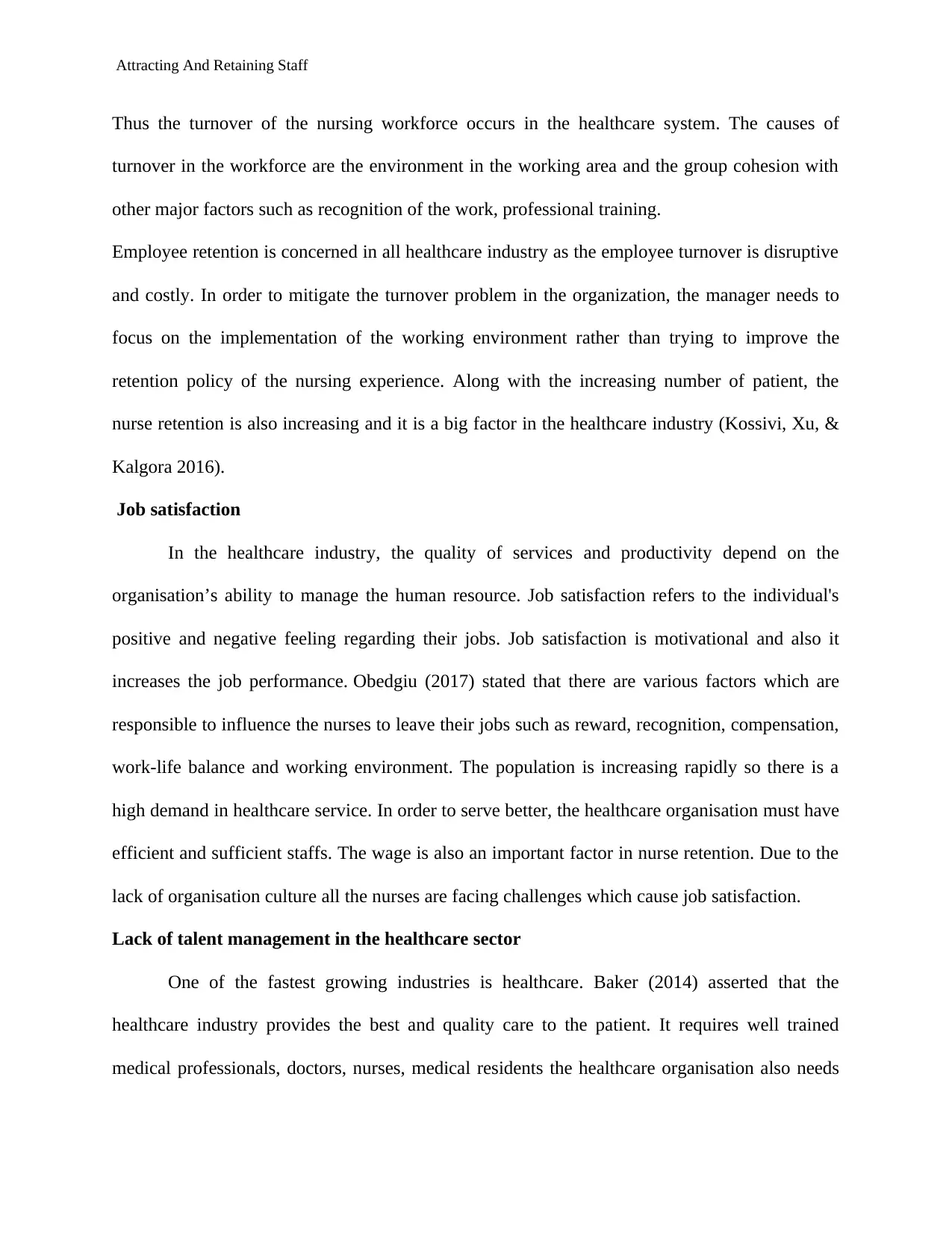
Attracting And Retaining Staff
Thus the turnover of the nursing workforce occurs in the healthcare system. The causes of
turnover in the workforce are the environment in the working area and the group cohesion with
other major factors such as recognition of the work, professional training.
Employee retention is concerned in all healthcare industry as the employee turnover is disruptive
and costly. In order to mitigate the turnover problem in the organization, the manager needs to
focus on the implementation of the working environment rather than trying to improve the
retention policy of the nursing experience. Along with the increasing number of patient, the
nurse retention is also increasing and it is a big factor in the healthcare industry (Kossivi, Xu, &
Kalgora 2016).
Job satisfaction
In the healthcare industry, the quality of services and productivity depend on the
organisation’s ability to manage the human resource. Job satisfaction refers to the individual's
positive and negative feeling regarding their jobs. Job satisfaction is motivational and also it
increases the job performance. Obedgiu (2017) stated that there are various factors which are
responsible to influence the nurses to leave their jobs such as reward, recognition, compensation,
work-life balance and working environment. The population is increasing rapidly so there is a
high demand in healthcare service. In order to serve better, the healthcare organisation must have
efficient and sufficient staffs. The wage is also an important factor in nurse retention. Due to the
lack of organisation culture all the nurses are facing challenges which cause job satisfaction.
Lack of talent management in the healthcare sector
One of the fastest growing industries is healthcare. Baker (2014) asserted that the
healthcare industry provides the best and quality care to the patient. It requires well trained
medical professionals, doctors, nurses, medical residents the healthcare organisation also needs
Thus the turnover of the nursing workforce occurs in the healthcare system. The causes of
turnover in the workforce are the environment in the working area and the group cohesion with
other major factors such as recognition of the work, professional training.
Employee retention is concerned in all healthcare industry as the employee turnover is disruptive
and costly. In order to mitigate the turnover problem in the organization, the manager needs to
focus on the implementation of the working environment rather than trying to improve the
retention policy of the nursing experience. Along with the increasing number of patient, the
nurse retention is also increasing and it is a big factor in the healthcare industry (Kossivi, Xu, &
Kalgora 2016).
Job satisfaction
In the healthcare industry, the quality of services and productivity depend on the
organisation’s ability to manage the human resource. Job satisfaction refers to the individual's
positive and negative feeling regarding their jobs. Job satisfaction is motivational and also it
increases the job performance. Obedgiu (2017) stated that there are various factors which are
responsible to influence the nurses to leave their jobs such as reward, recognition, compensation,
work-life balance and working environment. The population is increasing rapidly so there is a
high demand in healthcare service. In order to serve better, the healthcare organisation must have
efficient and sufficient staffs. The wage is also an important factor in nurse retention. Due to the
lack of organisation culture all the nurses are facing challenges which cause job satisfaction.
Lack of talent management in the healthcare sector
One of the fastest growing industries is healthcare. Baker (2014) asserted that the
healthcare industry provides the best and quality care to the patient. It requires well trained
medical professionals, doctors, nurses, medical residents the healthcare organisation also needs
Paraphrase This Document
Need a fresh take? Get an instant paraphrase of this document with our AI Paraphraser
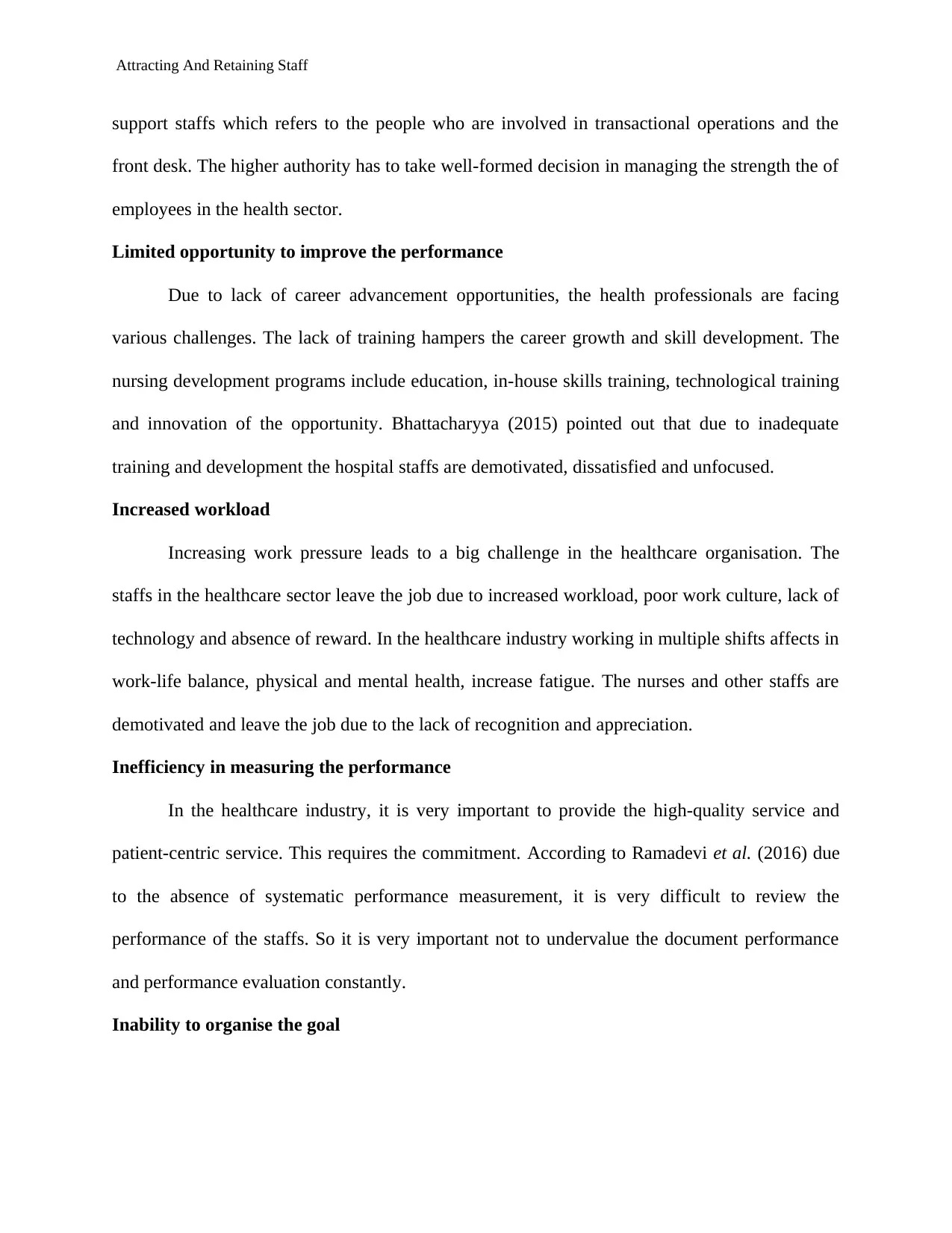
Attracting And Retaining Staff
support staffs which refers to the people who are involved in transactional operations and the
front desk. The higher authority has to take well-formed decision in managing the strength the of
employees in the health sector.
Limited opportunity to improve the performance
Due to lack of career advancement opportunities, the health professionals are facing
various challenges. The lack of training hampers the career growth and skill development. The
nursing development programs include education, in-house skills training, technological training
and innovation of the opportunity. Bhattacharyya (2015) pointed out that due to inadequate
training and development the hospital staffs are demotivated, dissatisfied and unfocused.
Increased workload
Increasing work pressure leads to a big challenge in the healthcare organisation. The
staffs in the healthcare sector leave the job due to increased workload, poor work culture, lack of
technology and absence of reward. In the healthcare industry working in multiple shifts affects in
work-life balance, physical and mental health, increase fatigue. The nurses and other staffs are
demotivated and leave the job due to the lack of recognition and appreciation.
Inefficiency in measuring the performance
In the healthcare industry, it is very important to provide the high-quality service and
patient-centric service. This requires the commitment. According to Ramadevi et al. (2016) due
to the absence of systematic performance measurement, it is very difficult to review the
performance of the staffs. So it is very important not to undervalue the document performance
and performance evaluation constantly.
Inability to organise the goal
support staffs which refers to the people who are involved in transactional operations and the
front desk. The higher authority has to take well-formed decision in managing the strength the of
employees in the health sector.
Limited opportunity to improve the performance
Due to lack of career advancement opportunities, the health professionals are facing
various challenges. The lack of training hampers the career growth and skill development. The
nursing development programs include education, in-house skills training, technological training
and innovation of the opportunity. Bhattacharyya (2015) pointed out that due to inadequate
training and development the hospital staffs are demotivated, dissatisfied and unfocused.
Increased workload
Increasing work pressure leads to a big challenge in the healthcare organisation. The
staffs in the healthcare sector leave the job due to increased workload, poor work culture, lack of
technology and absence of reward. In the healthcare industry working in multiple shifts affects in
work-life balance, physical and mental health, increase fatigue. The nurses and other staffs are
demotivated and leave the job due to the lack of recognition and appreciation.
Inefficiency in measuring the performance
In the healthcare industry, it is very important to provide the high-quality service and
patient-centric service. This requires the commitment. According to Ramadevi et al. (2016) due
to the absence of systematic performance measurement, it is very difficult to review the
performance of the staffs. So it is very important not to undervalue the document performance
and performance evaluation constantly.
Inability to organise the goal
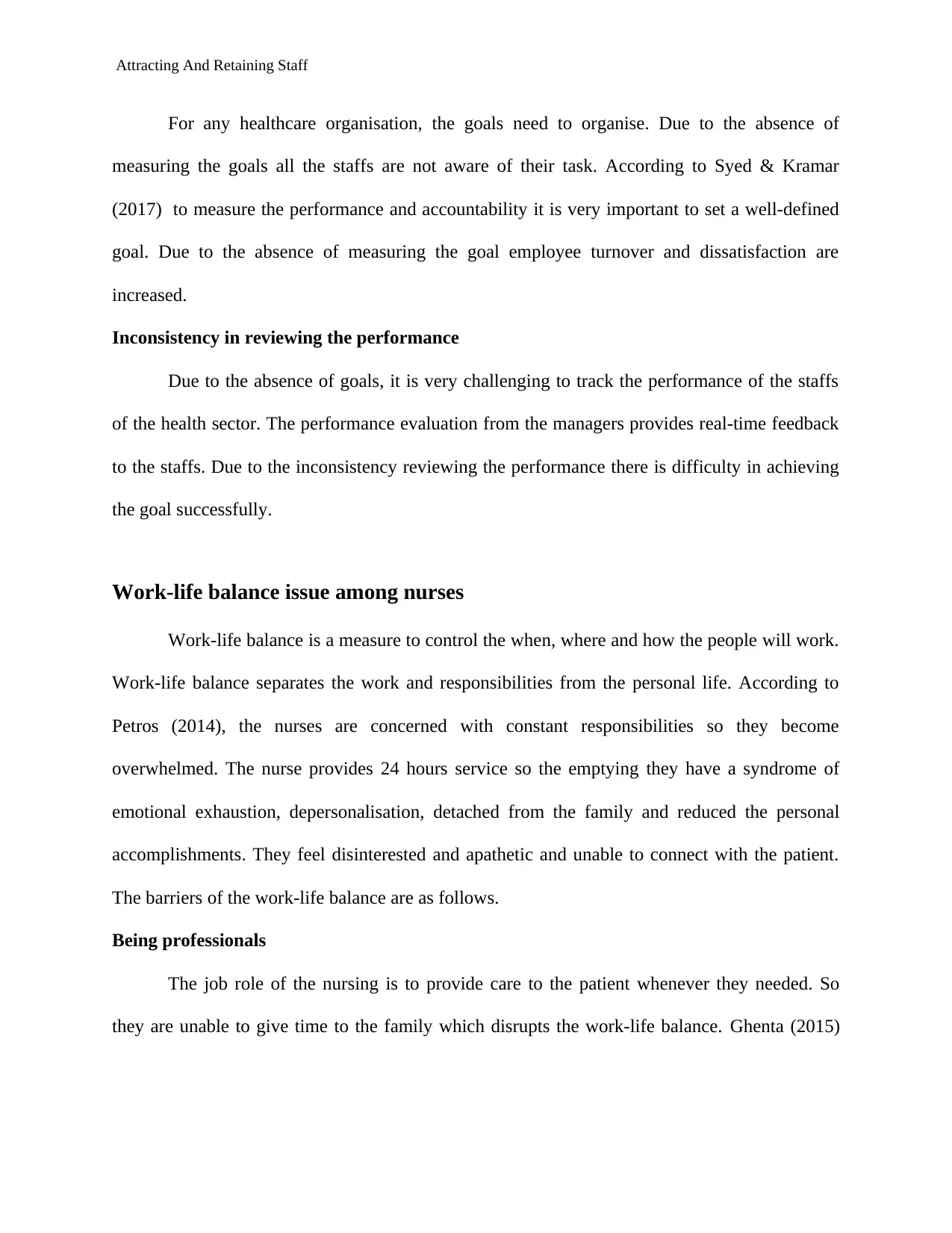
Attracting And Retaining Staff
For any healthcare organisation, the goals need to organise. Due to the absence of
measuring the goals all the staffs are not aware of their task. According to Syed & Kramar
(2017) to measure the performance and accountability it is very important to set a well-defined
goal. Due to the absence of measuring the goal employee turnover and dissatisfaction are
increased.
Inconsistency in reviewing the performance
Due to the absence of goals, it is very challenging to track the performance of the staffs
of the health sector. The performance evaluation from the managers provides real-time feedback
to the staffs. Due to the inconsistency reviewing the performance there is difficulty in achieving
the goal successfully.
Work-life balance issue among nurses
Work-life balance is a measure to control the when, where and how the people will work.
Work-life balance separates the work and responsibilities from the personal life. According to
Petros (2014), the nurses are concerned with constant responsibilities so they become
overwhelmed. The nurse provides 24 hours service so the emptying they have a syndrome of
emotional exhaustion, depersonalisation, detached from the family and reduced the personal
accomplishments. They feel disinterested and apathetic and unable to connect with the patient.
The barriers of the work-life balance are as follows.
Being professionals
The job role of the nursing is to provide care to the patient whenever they needed. So
they are unable to give time to the family which disrupts the work-life balance. Ghenta (2015)
For any healthcare organisation, the goals need to organise. Due to the absence of
measuring the goals all the staffs are not aware of their task. According to Syed & Kramar
(2017) to measure the performance and accountability it is very important to set a well-defined
goal. Due to the absence of measuring the goal employee turnover and dissatisfaction are
increased.
Inconsistency in reviewing the performance
Due to the absence of goals, it is very challenging to track the performance of the staffs
of the health sector. The performance evaluation from the managers provides real-time feedback
to the staffs. Due to the inconsistency reviewing the performance there is difficulty in achieving
the goal successfully.
Work-life balance issue among nurses
Work-life balance is a measure to control the when, where and how the people will work.
Work-life balance separates the work and responsibilities from the personal life. According to
Petros (2014), the nurses are concerned with constant responsibilities so they become
overwhelmed. The nurse provides 24 hours service so the emptying they have a syndrome of
emotional exhaustion, depersonalisation, detached from the family and reduced the personal
accomplishments. They feel disinterested and apathetic and unable to connect with the patient.
The barriers of the work-life balance are as follows.
Being professionals
The job role of the nursing is to provide care to the patient whenever they needed. So
they are unable to give time to the family which disrupts the work-life balance. Ghenta (2015)
⊘ This is a preview!⊘
Do you want full access?
Subscribe today to unlock all pages.

Trusted by 1+ million students worldwide

Attracting And Retaining Staff
asserted that the unbalanced work-life creates a negative impact on the nurses and other staffs
which causes job satisfaction and decrease the nurse’s quality of life.
Giving people 24 hours service
The nurses are doing day shift as well as night shift. Ganapathy & Ashokkumar (2017)
pointed out that they provide 24 hours services to the patient. This not only affects their physical
but also their mental health. Due to overwork stress, the work-life balance break and they cannot
live a life happily with their family. Working condition and working environment also affect the
work-life balance structure. Most of the nurses are overworked and for that, they are in a state of
work-life imbalance.
Give reaction to the entire patient
The job of the nurse is to look after each and every patient and give reaction to everyone.
As the number of nurses is reducing so the workload is increasing which disrupt the work-life
balance. As a result, the nurses leave their jobs due to the excessive work pressure. Due to the
unbalanced work-life balance, the nurses are demotivated, dissatisfied. It also creates many
physical and mental health-related issues (Onken-Menke, Nüesch & Kröll 2018).
Recruitment issue in the healthcare sector
Hiring and Recruitment in health industry are very challenging for factor for the recruiter.
Lasala (2017) asserted that in order to hire the highly qualified healthcare professionals the HR
and recruit managers have to struggle. Due to the poor infrastructure, the staffs are separated
from the workforce and leave their job. The health industry is not able to provide the quality
services due to the rising in vacancies. The main issues for recruitment and distribution of the
asserted that the unbalanced work-life creates a negative impact on the nurses and other staffs
which causes job satisfaction and decrease the nurse’s quality of life.
Giving people 24 hours service
The nurses are doing day shift as well as night shift. Ganapathy & Ashokkumar (2017)
pointed out that they provide 24 hours services to the patient. This not only affects their physical
but also their mental health. Due to overwork stress, the work-life balance break and they cannot
live a life happily with their family. Working condition and working environment also affect the
work-life balance structure. Most of the nurses are overworked and for that, they are in a state of
work-life imbalance.
Give reaction to the entire patient
The job of the nurse is to look after each and every patient and give reaction to everyone.
As the number of nurses is reducing so the workload is increasing which disrupt the work-life
balance. As a result, the nurses leave their jobs due to the excessive work pressure. Due to the
unbalanced work-life balance, the nurses are demotivated, dissatisfied. It also creates many
physical and mental health-related issues (Onken-Menke, Nüesch & Kröll 2018).
Recruitment issue in the healthcare sector
Hiring and Recruitment in health industry are very challenging for factor for the recruiter.
Lasala (2017) asserted that in order to hire the highly qualified healthcare professionals the HR
and recruit managers have to struggle. Due to the poor infrastructure, the staffs are separated
from the workforce and leave their job. The health industry is not able to provide the quality
services due to the rising in vacancies. The main issues for recruitment and distribution of the
Paraphrase This Document
Need a fresh take? Get an instant paraphrase of this document with our AI Paraphraser
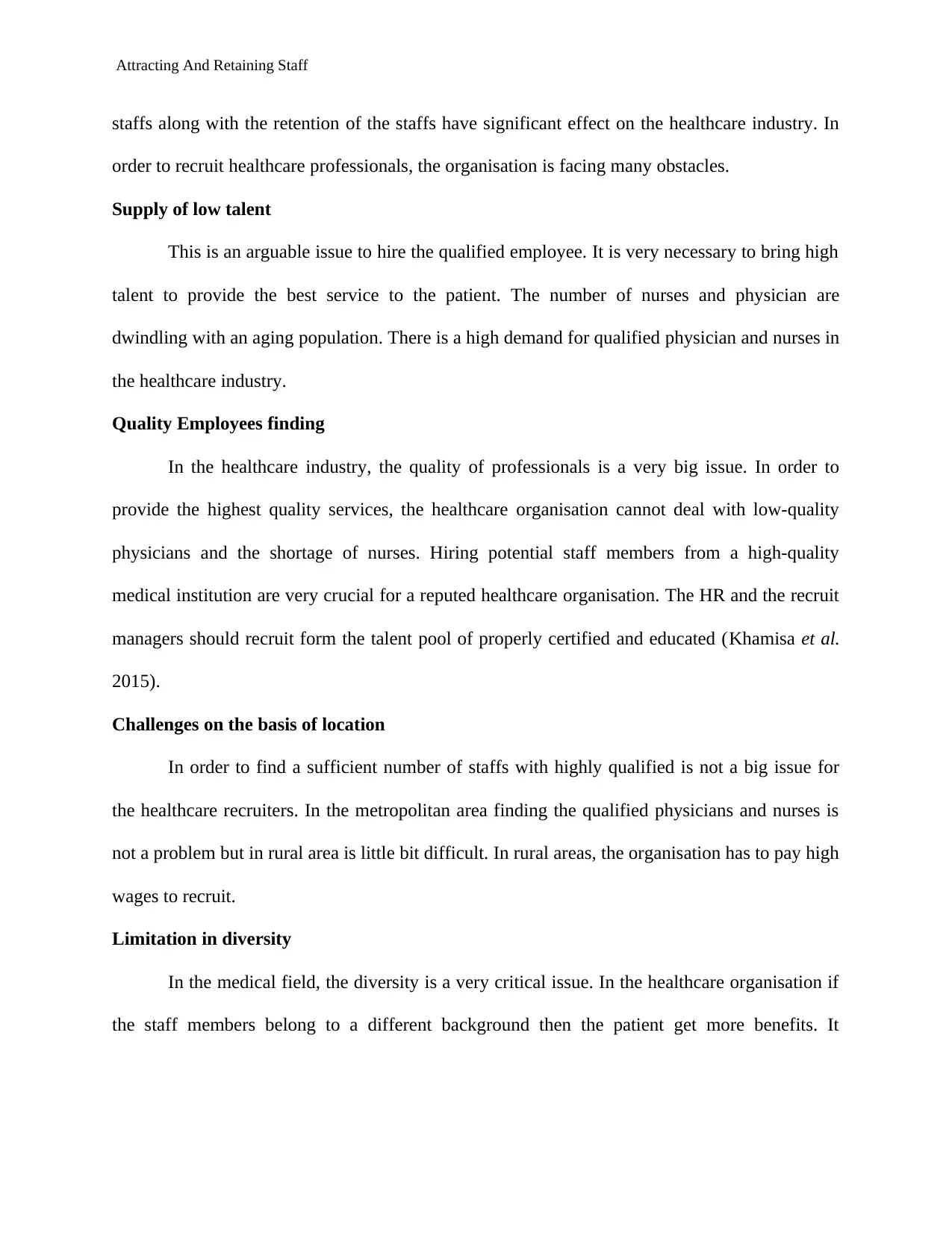
Attracting And Retaining Staff
staffs along with the retention of the staffs have significant effect on the healthcare industry. In
order to recruit healthcare professionals, the organisation is facing many obstacles.
Supply of low talent
This is an arguable issue to hire the qualified employee. It is very necessary to bring high
talent to provide the best service to the patient. The number of nurses and physician are
dwindling with an aging population. There is a high demand for qualified physician and nurses in
the healthcare industry.
Quality Employees finding
In the healthcare industry, the quality of professionals is a very big issue. In order to
provide the highest quality services, the healthcare organisation cannot deal with low-quality
physicians and the shortage of nurses. Hiring potential staff members from a high-quality
medical institution are very crucial for a reputed healthcare organisation. The HR and the recruit
managers should recruit form the talent pool of properly certified and educated (Khamisa et al.
2015).
Challenges on the basis of location
In order to find a sufficient number of staffs with highly qualified is not a big issue for
the healthcare recruiters. In the metropolitan area finding the qualified physicians and nurses is
not a problem but in rural area is little bit difficult. In rural areas, the organisation has to pay high
wages to recruit.
Limitation in diversity
In the medical field, the diversity is a very critical issue. In the healthcare organisation if
the staff members belong to a different background then the patient get more benefits. It
staffs along with the retention of the staffs have significant effect on the healthcare industry. In
order to recruit healthcare professionals, the organisation is facing many obstacles.
Supply of low talent
This is an arguable issue to hire the qualified employee. It is very necessary to bring high
talent to provide the best service to the patient. The number of nurses and physician are
dwindling with an aging population. There is a high demand for qualified physician and nurses in
the healthcare industry.
Quality Employees finding
In the healthcare industry, the quality of professionals is a very big issue. In order to
provide the highest quality services, the healthcare organisation cannot deal with low-quality
physicians and the shortage of nurses. Hiring potential staff members from a high-quality
medical institution are very crucial for a reputed healthcare organisation. The HR and the recruit
managers should recruit form the talent pool of properly certified and educated (Khamisa et al.
2015).
Challenges on the basis of location
In order to find a sufficient number of staffs with highly qualified is not a big issue for
the healthcare recruiters. In the metropolitan area finding the qualified physicians and nurses is
not a problem but in rural area is little bit difficult. In rural areas, the organisation has to pay high
wages to recruit.
Limitation in diversity
In the medical field, the diversity is a very critical issue. In the healthcare organisation if
the staff members belong to a different background then the patient get more benefits. It

Attracting And Retaining Staff
increases the patient satisfaction. Depending on the location diversity is a big challenge for the
healthcare sector (Gibson, Dixon & Abrams 2015).
Lengthy recruitment
The most adulating challenge faced by the healthcare industry is the lengthy recruitment
cycle. In order to fill the vacancy of a specific healthcare position, it takes several months in a
year. The existing staffs are overworked and many of them leave the job so it is necessary to fill
the gap. Due to the lengthy recruitment cycle, the patient is not satisfied with the services
provided by the healthcare sector.
Lack of teamwork in healthcare care setting
The healthcare industry is accountable to provide the services on the emergency basis. So
in the case of teamwork it is very important to provide effective services. There is a high demand
for physicians and nurses in the healthcare industry. According to West & Lyubovnikova (2013)
if the people need any medical attention so they cannot be refused so the work pressure for the
medical staffs is increasing. In order to mitigate this problem, the teamwork is needed as the
teamwork enables the healthcare sector to divide the workload among the entire workforce. The
organisational support, team structure, team task affects the team and leadership. The
organisational support from the team member plays vital role in not only achieving the goal but
also increasing the job satisfaction of the staffs. The teamwork helps to improve a productive and
friendly environment which helps the nurse to work efficiently. A successful team includes
various characteristics.
Shared goals
increases the patient satisfaction. Depending on the location diversity is a big challenge for the
healthcare sector (Gibson, Dixon & Abrams 2015).
Lengthy recruitment
The most adulating challenge faced by the healthcare industry is the lengthy recruitment
cycle. In order to fill the vacancy of a specific healthcare position, it takes several months in a
year. The existing staffs are overworked and many of them leave the job so it is necessary to fill
the gap. Due to the lengthy recruitment cycle, the patient is not satisfied with the services
provided by the healthcare sector.
Lack of teamwork in healthcare care setting
The healthcare industry is accountable to provide the services on the emergency basis. So
in the case of teamwork it is very important to provide effective services. There is a high demand
for physicians and nurses in the healthcare industry. According to West & Lyubovnikova (2013)
if the people need any medical attention so they cannot be refused so the work pressure for the
medical staffs is increasing. In order to mitigate this problem, the teamwork is needed as the
teamwork enables the healthcare sector to divide the workload among the entire workforce. The
organisational support, team structure, team task affects the team and leadership. The
organisational support from the team member plays vital role in not only achieving the goal but
also increasing the job satisfaction of the staffs. The teamwork helps to improve a productive and
friendly environment which helps the nurse to work efficiently. A successful team includes
various characteristics.
Shared goals
⊘ This is a preview!⊘
Do you want full access?
Subscribe today to unlock all pages.

Trusted by 1+ million students worldwide
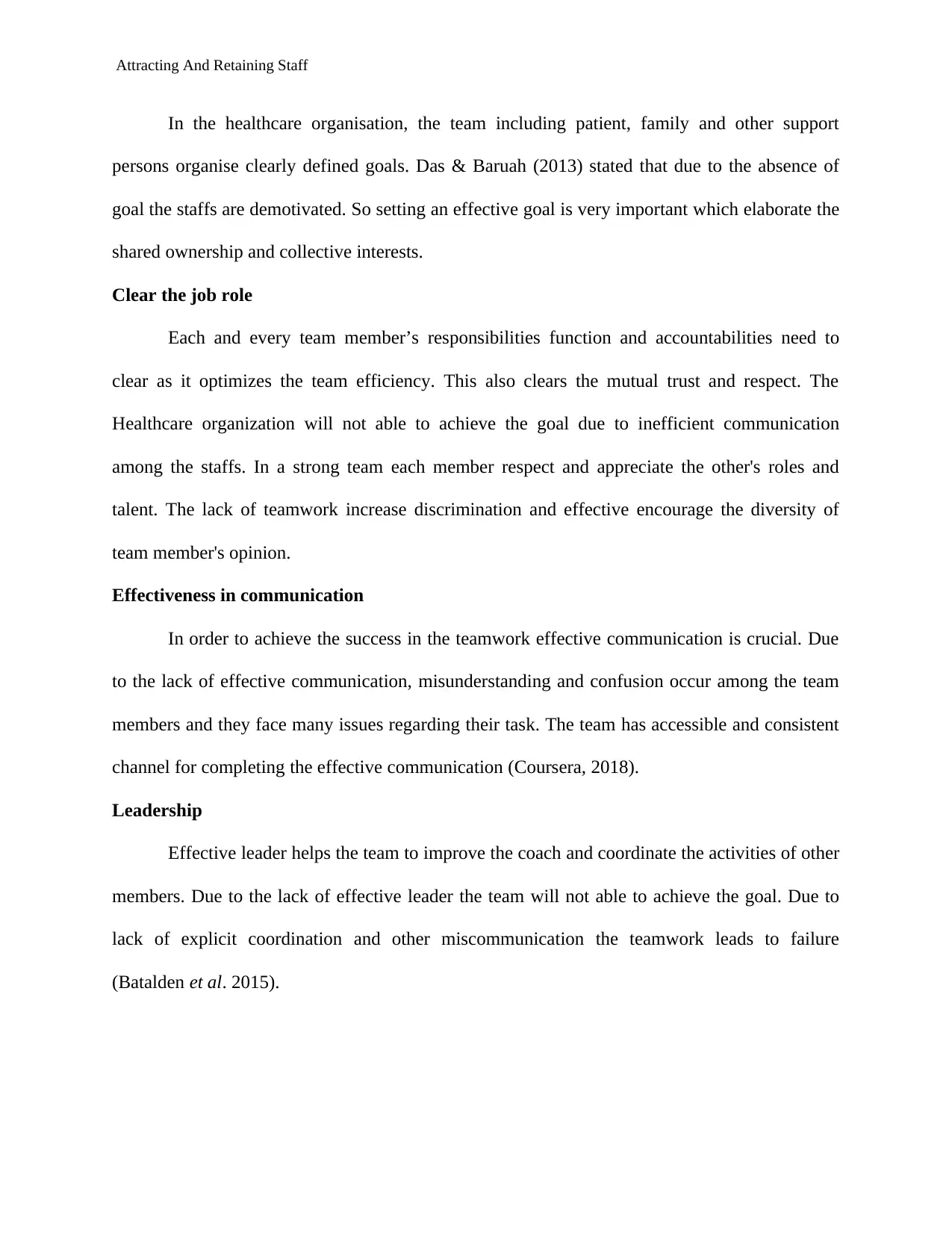
Attracting And Retaining Staff
In the healthcare organisation, the team including patient, family and other support
persons organise clearly defined goals. Das & Baruah (2013) stated that due to the absence of
goal the staffs are demotivated. So setting an effective goal is very important which elaborate the
shared ownership and collective interests.
Clear the job role
Each and every team member’s responsibilities function and accountabilities need to
clear as it optimizes the team efficiency. This also clears the mutual trust and respect. The
Healthcare organization will not able to achieve the goal due to inefficient communication
among the staffs. In a strong team each member respect and appreciate the other's roles and
talent. The lack of teamwork increase discrimination and effective encourage the diversity of
team member's opinion.
Effectiveness in communication
In order to achieve the success in the teamwork effective communication is crucial. Due
to the lack of effective communication, misunderstanding and confusion occur among the team
members and they face many issues regarding their task. The team has accessible and consistent
channel for completing the effective communication (Coursera, 2018).
Leadership
Effective leader helps the team to improve the coach and coordinate the activities of other
members. Due to the lack of effective leader the team will not able to achieve the goal. Due to
lack of explicit coordination and other miscommunication the teamwork leads to failure
(Batalden et al. 2015).
In the healthcare organisation, the team including patient, family and other support
persons organise clearly defined goals. Das & Baruah (2013) stated that due to the absence of
goal the staffs are demotivated. So setting an effective goal is very important which elaborate the
shared ownership and collective interests.
Clear the job role
Each and every team member’s responsibilities function and accountabilities need to
clear as it optimizes the team efficiency. This also clears the mutual trust and respect. The
Healthcare organization will not able to achieve the goal due to inefficient communication
among the staffs. In a strong team each member respect and appreciate the other's roles and
talent. The lack of teamwork increase discrimination and effective encourage the diversity of
team member's opinion.
Effectiveness in communication
In order to achieve the success in the teamwork effective communication is crucial. Due
to the lack of effective communication, misunderstanding and confusion occur among the team
members and they face many issues regarding their task. The team has accessible and consistent
channel for completing the effective communication (Coursera, 2018).
Leadership
Effective leader helps the team to improve the coach and coordinate the activities of other
members. Due to the lack of effective leader the team will not able to achieve the goal. Due to
lack of explicit coordination and other miscommunication the teamwork leads to failure
(Batalden et al. 2015).
Paraphrase This Document
Need a fresh take? Get an instant paraphrase of this document with our AI Paraphraser
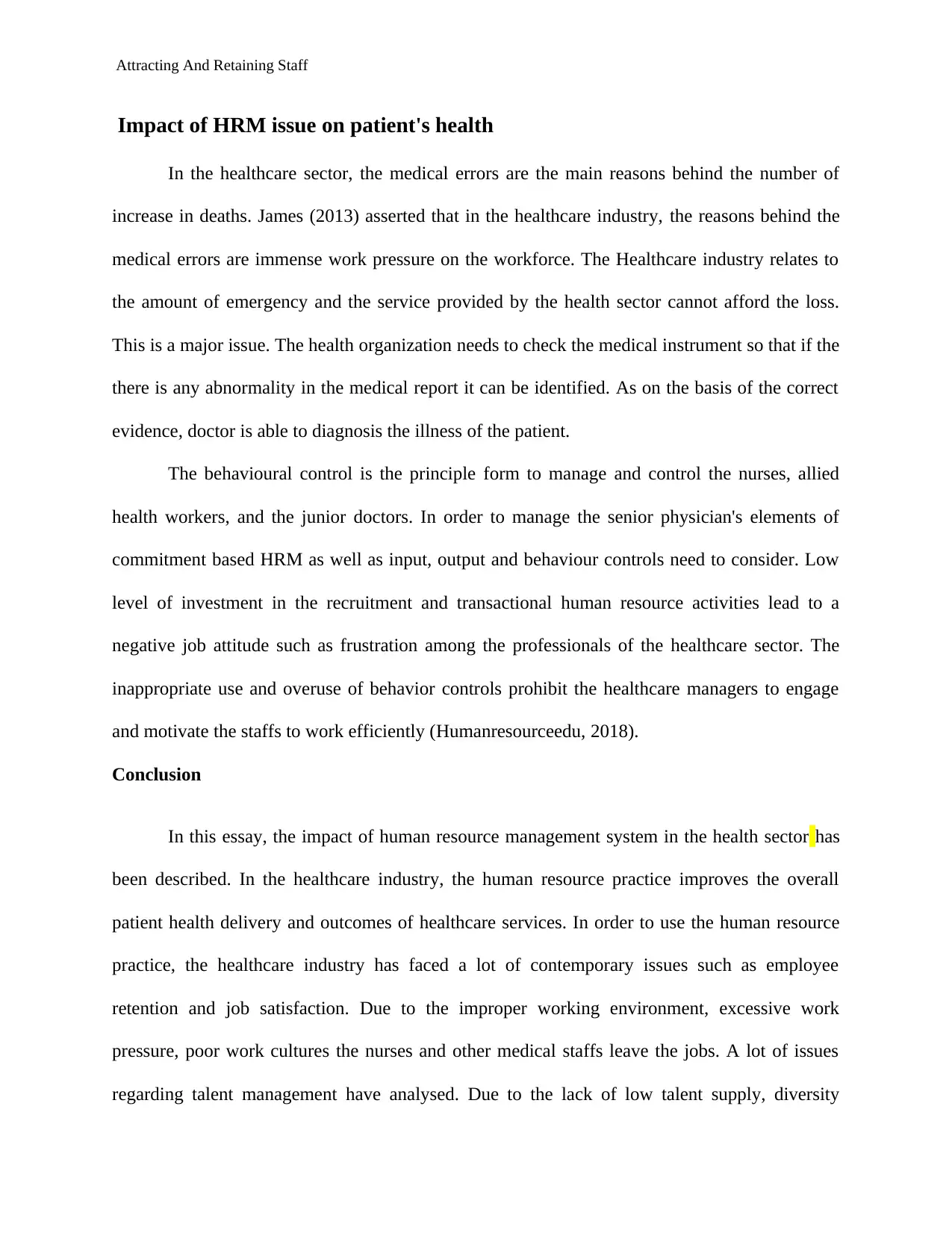
Attracting And Retaining Staff
Impact of HRM issue on patient's health
In the healthcare sector, the medical errors are the main reasons behind the number of
increase in deaths. James (2013) asserted that in the healthcare industry, the reasons behind the
medical errors are immense work pressure on the workforce. The Healthcare industry relates to
the amount of emergency and the service provided by the health sector cannot afford the loss.
This is a major issue. The health organization needs to check the medical instrument so that if the
there is any abnormality in the medical report it can be identified. As on the basis of the correct
evidence, doctor is able to diagnosis the illness of the patient.
The behavioural control is the principle form to manage and control the nurses, allied
health workers, and the junior doctors. In order to manage the senior physician's elements of
commitment based HRM as well as input, output and behaviour controls need to consider. Low
level of investment in the recruitment and transactional human resource activities lead to a
negative job attitude such as frustration among the professionals of the healthcare sector. The
inappropriate use and overuse of behavior controls prohibit the healthcare managers to engage
and motivate the staffs to work efficiently (Humanresourceedu, 2018).
Conclusion
In this essay, the impact of human resource management system in the health sector has
been described. In the healthcare industry, the human resource practice improves the overall
patient health delivery and outcomes of healthcare services. In order to use the human resource
practice, the healthcare industry has faced a lot of contemporary issues such as employee
retention and job satisfaction. Due to the improper working environment, excessive work
pressure, poor work cultures the nurses and other medical staffs leave the jobs. A lot of issues
regarding talent management have analysed. Due to the lack of low talent supply, diversity
Impact of HRM issue on patient's health
In the healthcare sector, the medical errors are the main reasons behind the number of
increase in deaths. James (2013) asserted that in the healthcare industry, the reasons behind the
medical errors are immense work pressure on the workforce. The Healthcare industry relates to
the amount of emergency and the service provided by the health sector cannot afford the loss.
This is a major issue. The health organization needs to check the medical instrument so that if the
there is any abnormality in the medical report it can be identified. As on the basis of the correct
evidence, doctor is able to diagnosis the illness of the patient.
The behavioural control is the principle form to manage and control the nurses, allied
health workers, and the junior doctors. In order to manage the senior physician's elements of
commitment based HRM as well as input, output and behaviour controls need to consider. Low
level of investment in the recruitment and transactional human resource activities lead to a
negative job attitude such as frustration among the professionals of the healthcare sector. The
inappropriate use and overuse of behavior controls prohibit the healthcare managers to engage
and motivate the staffs to work efficiently (Humanresourceedu, 2018).
Conclusion
In this essay, the impact of human resource management system in the health sector has
been described. In the healthcare industry, the human resource practice improves the overall
patient health delivery and outcomes of healthcare services. In order to use the human resource
practice, the healthcare industry has faced a lot of contemporary issues such as employee
retention and job satisfaction. Due to the improper working environment, excessive work
pressure, poor work cultures the nurses and other medical staffs leave the jobs. A lot of issues
regarding talent management have analysed. Due to the lack of low talent supply, diversity
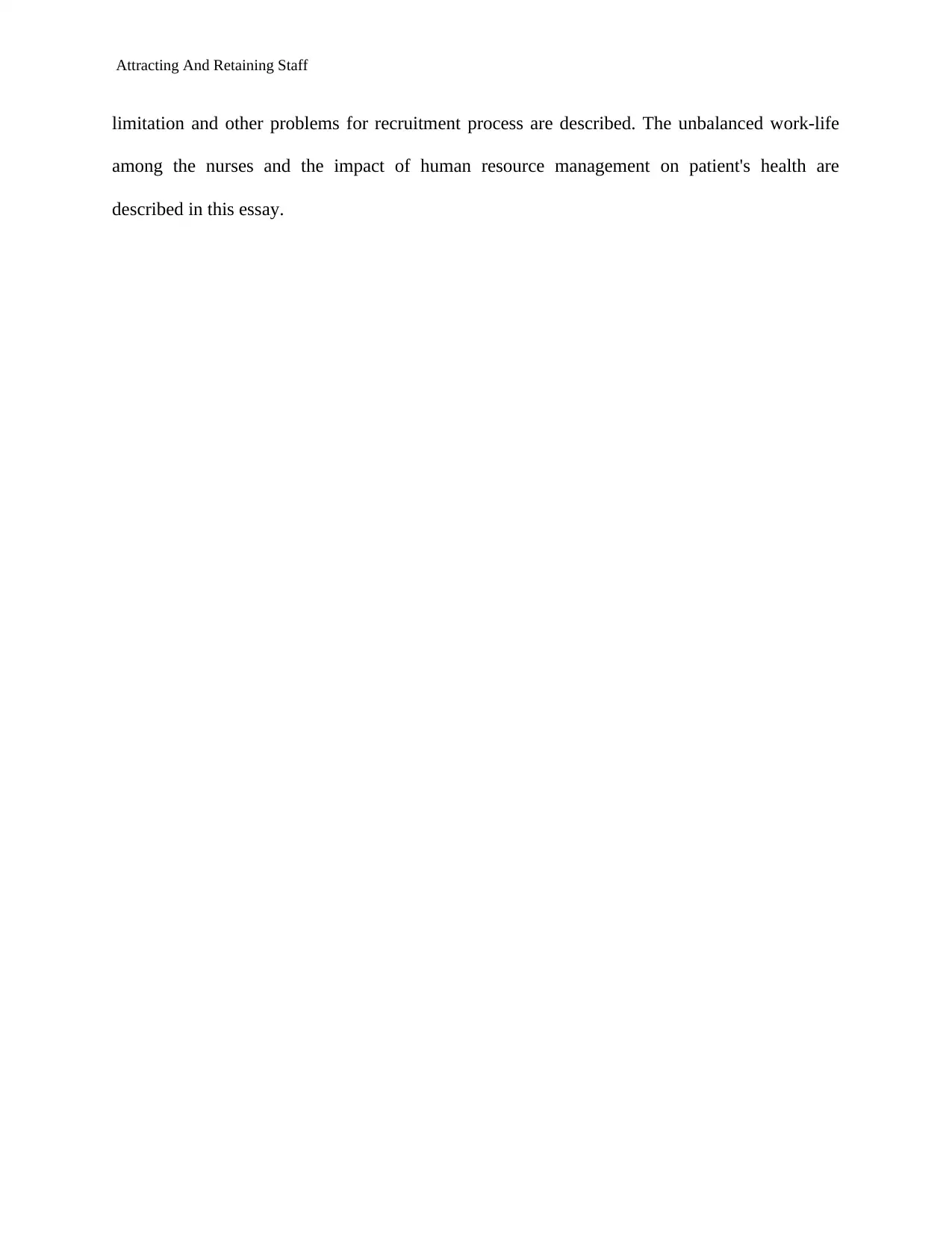
Attracting And Retaining Staff
limitation and other problems for recruitment process are described. The unbalanced work-life
among the nurses and the impact of human resource management on patient's health are
described in this essay.
limitation and other problems for recruitment process are described. The unbalanced work-life
among the nurses and the impact of human resource management on patient's health are
described in this essay.
⊘ This is a preview!⊘
Do you want full access?
Subscribe today to unlock all pages.

Trusted by 1+ million students worldwide
1 out of 16
Related Documents
Your All-in-One AI-Powered Toolkit for Academic Success.
+13062052269
info@desklib.com
Available 24*7 on WhatsApp / Email
![[object Object]](/_next/static/media/star-bottom.7253800d.svg)
Unlock your academic potential
Copyright © 2020–2025 A2Z Services. All Rights Reserved. Developed and managed by ZUCOL.




